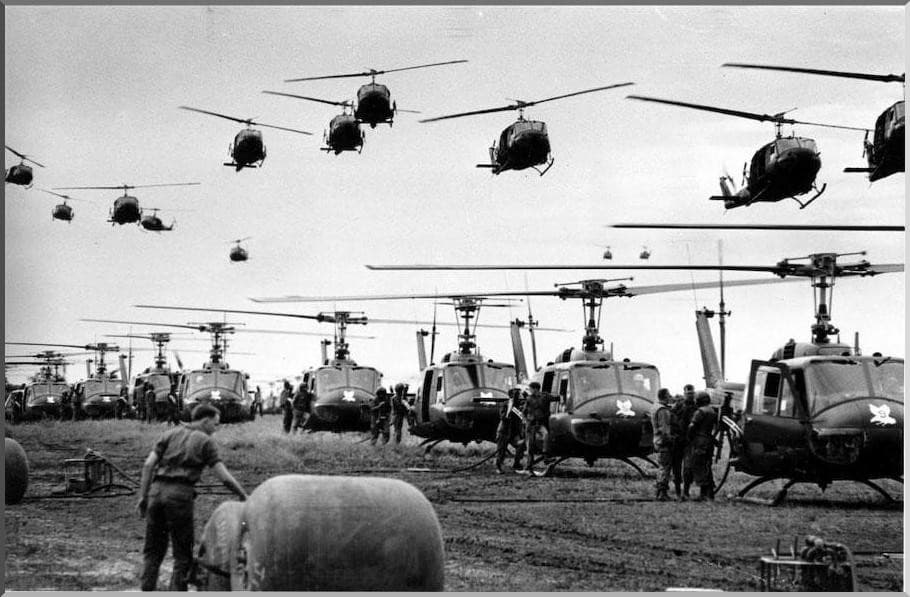Vietnam [1965-1968]
Operation Rolling Thunder was a military operation conducted by the United States of America against North Vietnam from 2 March 1965 to 2 November 1968.
The operation had the aim of destroying North Vietnam's transportation network, industrial base, and air defenses to support ground operations in South Vietnam.

The political objectives of Operation Rolling Thunder was to force North Vietnam's leaders to begin negotiating for peace. It ended up lasting more than three years and became the longest bombing campaign in U.S history, but it failed at its goal of defeating North Vietnamese forces or ending their support for Viet Cong operations against South Vietnam.
Though President Johnson had ordered Operation Rolling Thunder as a way to achieve limited war goals without sending in ground troops, he wanted the bombing campaign to ultimately convince North Vietnam's leaders into accepting a US-backed ceasefire and political settlement for ending the war by halting their support for Viet Cong operations in South Vietnam.
The military objectives of Operation Rolling Thunder during the Vietnam War were to destroy North Vietnamese transportation and industrial infrastructures as well as military targets in order to halt communist aggression against South Vietnam.The Chi Minh trail, also known as the Truong Son Strategic Supply Route, was used by North Vietnam to transport supplies and troops throughout the war. Operation Rolling Thunder didn't bomb the Ho Chi Minh Trail but it succeeded at bombing many different targets including troop concentrations, airfields, dams and bridges.
Though President Johnson had ordered Operation Rolling Thunder as a way to achieve limited war goals without sending in ground troops, he wanted the bombing campaign to ultimately convince North Vietnam's leaders into accepting a US-backed ceasefire and political settlement for ending the war by halting their support for Viet Cong operations in South Vietnam.
This led to an extended bombing campaign that lasted more than three years with many casualties on both sides before it ended up failing at its ultimate goal.
Operation Rolling Thunder represented a change in the US war strategy by moving away from strategic raids on military bases and factories, which had been conducted since March 1965, to tactics that targeted North Vietnam's supply lines.
The bombing campaign was initially designed as an interdiction effort (aimed at slowing the movement of troops and supplies) but later became part of a policy known as "gradualism", where it would be applied continuously over time with greater intensity rather than being terminated if Hanoi adhered to Washington's terms for negotiations.
Ultimately, the bombing campaign failed to achieve its goal of forcing North Vietnam's leaders into accepting a US-backed ceasefire and political settlement for ending the war by halting their support for Viet Cong operations in South Vietnam.
This led to an extended bombing campaign lasting more than three years with many casualties on both sides before coming to a halt after failing at its ultimate goal.
Operation Rolling Thunder convinced the North Vietnamese to support guerilla warfare in South Vietnam because it showed them how strong their military was and that they were capable of fighting back against America's superior forces even after suffering major casualties.
It gave them confidence that if they continued, the US would eventually withdraw completely out of their territory giving all control back into communist hands which ultimately lead up to complete victory over Saigon (now Ho Chi Minh City).
The failure of operation Rolling Thunder resulted in fewer air strikes during 1968 as well as heavy criticism from other countries like France and Canada due to civilian deaths, while increasing pressure domestically within America because of rising protests against the war effort back home.
Though Operation Rolling Thunder is recorded in history as a failure, it was also seen to have led the way for future Presidents and their operations. It lead into President Nixon's tactic known as "Vietnamization", which focused on withdrawing US troops while transferring war responsibilities to South Vietnam.
This ultimately allowed him to end American involvement in direct combat with North Vietnamese forces by 1973 and brought about an official ceasefire between both parties until 1975 when they resumed again.
However, this did not last long because after repeated attacks from Hanoi that nearly overran Saigon (now Ho Chi Minh City), America had no choice but to withdraw all remaining personnel out of Vietnam left them completely vulnerable leading up to their fall.
Mcleod, S. "Operation Rolling Thunder: Facts & Summary." World History Blog, Oct 15, 2021. https://www.worldhistoryblog.com/Operation-Rolling-Thunder.html.